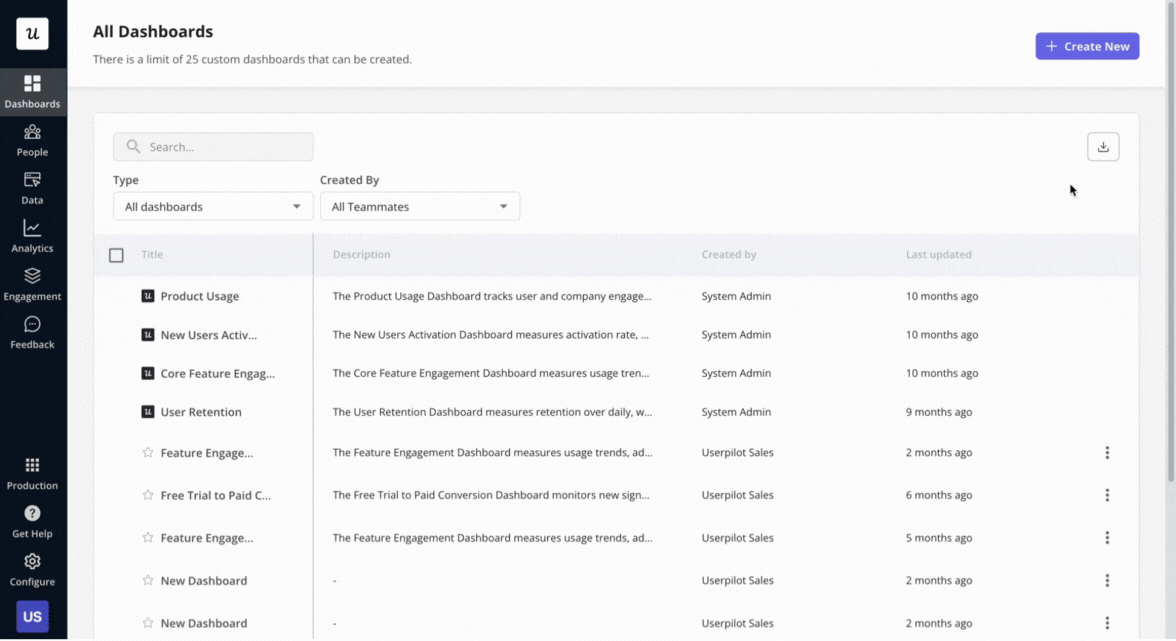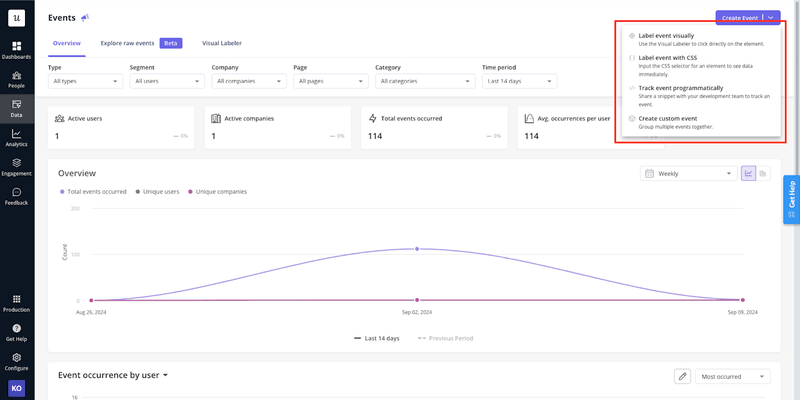
While “use data to drive decision-making” sounds obvious, there’s a HUGE gap between saying it and doing it well. So, how do you get started with product analytics?
In this article, we’ll talk about:
- What product analytics is and why you need a solid strategy.
- Key steps to build and improve your product analytics strategy.
- How to apply actionable metrics to different SaaS business stages.
Try Userpilot Now
See Why 1,000+ Teams Choose Userpilot

What is product analytics?
Product analytics refers to the process of gathering and analyzing data on how users interact with a product. It tracks key metrics such as feature usage, user flows, and behavior patterns to explore user preferences and pain points.
Is your product analytics strategy built for growth?
Collecting data is easy. Building a strategy that solves real business problems is hard. Take this 4-step assessment to audit your product analytics strategy.
Why should you have a product analytics strategy?
A product analytics strategy is essential for any business looking to make informed decisions about product development and user experience.
With a well-defined strategy, you can avoid misinterpreting data, making costly decisions, and missing out on key growth opportunities.
Plus, there are many reasons why you need a product analytics strategy:
- Aligns product development with user needs and business goals.
- Helps identify high-impact features and areas for improvement
- Reduces guesswork and fosters data-driven decision-making.
- Enables teams to track progress toward key performance indicators (KPIs).
- Improves product-market fit through actionable insights.
How to build a product analytics strategy?
Building a product analytics strategy ensures you’re collecting data and using it effectively to solve real problems.
Let’s explore the key steps in developing a robust product analytics strategy:
Define the issue you want to solve
The first step is to clearly define the core issues your business needs to address.
Start by identifying the top problems that your company faces, especially ones where you already have some data. These issues might range from low engagement with specific features to a high churn rate or poor user onboarding.
Then, as you define these problems, ensure you have a list of metrics that can adequately measure your product’s performance. If your current metrics are not enough, consider revising them by asking yourself:
Are leadership and all functional teams in agreement on which metrics matter most?
For instance, let’s say you find that users aren’t realizing the value of your product. To address this, you could meet with your team to agree on metrics related to onboarding, such as activation rate, time-to-value, and so on.
Decide how you can collect product analytics data
The next step is to assess your existing data infrastructure to determine whether it can support the data you need. This process may reveal gaps such as:
- Insufficient raw data.
- Outdated technology.
- Lack of team resources.
Depending on these gaps (and your budget), you’ll need to decide whether to invest in buying data or building a data infrastructure.
Now, developing an in-house solution typically requires a long development cycle, model testing, and ongoing maintenance—which can easily deplete both financial and human resources.
So for most companies, purchasing an analytics tool is a better option than building one from scratch.
Build the product analytics strategy workflow
Once you’ve defined the problem and determined how to collect the necessary data, you’ll need a workflow that will drive your product analytics strategy.
This workflow should detail how data will be collected, processed, and analyzed (and by who), as well as how insights will be communicated across the organization.
Think about this:
- Who will be responsible for data collection?
- How will it be analyzed?
- Who will share insights with other departments?
- Who will be responsible for data governance and quality assurance to ensure the accuracy and reliability of your data?
For example, your analytics team might collaborate with your product manager to ensure the data is interpreted in the right context. Then, the product team would relay insights to the marketing and customer success teams to ensure alignment across departments.
How to improve your product analytics strategy?
Once you have a strategy in place, the next challenge is ensuring it remains effective as your business evolves.
Let’s explore some key steps to enhance your strategy.
Determine your product data maturity level
Before you can improve your analytics strategy, it’s important to assess your product data maturity.
Maturity refers to how well your company collects, processes, and utilizes data in its decision-making process. A high level of data maturity means that your organization can successfully collect, transform, analyze, and leverage data across departments. On the other hand, a lower maturity level might indicate data silos, incomplete data, or difficulty turning insights into action.
If you’re not sure, here’s a Data Maturity Assessment by DataCamp to evaluate your company’s maturity.
Use it to identify gaps in your current setup and solve them. For instance, if you find that you lack the infrastructure to integrate data from different platforms, you can then invest in new tools or reorganize data governance processes.
Focus on actionable product metrics
While it’s easy to get lost in a sea of metrics (like churn rate, customer lifetime value, or monthly recurring revenue) not all metrics are equally useful.
The most actionable metrics are those that provide insight into why your product is performing a certain way. To find them, classify all of them based on their impact and priority in your business.
Then, only pay attention to the most impactful numbers and ignore the noise.
For example, rather than solely relying on basic churn metrics, consider growth accounting metrics like the quick ratio to understand how this affects your financial resilience.
Foster a data-driven culture
The final element of improving your product analytics strategy is fostering a data-driven culture throughout your organization.
However, this shift requires democratizing access to analytics, so team members across departments can pull up reports and insights without relying on technical expertise.
To help with this, no-code product analytics platforms allow your product managers, marketers, and customer success teams to run their own analyses, track user behavior, and generate quick reports. This speeds up decision-making and makes teams adapt quickly based on the latest data.
An example of this is how a no-code tool like Userpilot allows customer success teams to monitor feature usage and proactively address customer issues before they escalate into churn.

What does a product analytics strategy look like for SaaS companies in different stages?
As businesses grow and mature, their analytics needs evolve, requiring different approaches to how data is collected, interpreted, and used.
Let’s explore how these strategies vary across early-stage, growth-stage, and mature SaaS companies:
- For early-stage companies, the goal is to identify which features are gaining traction and which ones are being overlooked in order to ensure product-market fit. This often involves creating detailed reports on user behavior, tagging features to track clicks, opportunity sizing, and doing deep dives when launching new features.
- Growth-stage companies need to scale their product analytics to manage a larger user base and more complex customer journeys. For this, they must refine their data governance processes to ensure data accuracy and security as their user base grows. This would allow deeper insights into user retention, feature adoption, and upsell opportunities.
- For mature SaaS companies, the challenge is less about understanding how users engage with the product and more about fine-tuning product features and monetization strategies to maximize profitability. For this, these companies often invest in predictive analytics to anticipate trends, perform experiments, and ideate more features for the product roadmap.
Best product analytics tools to consider
Choosing the right product analytics tool is non-negotiable (you just can’t get away with Google Analytics.)
Whether you’re looking for an all-in-one solution or a specialized product analytics solution, several options on the market can cater to your specific needs:
- Userpilot. Userpilot is a no-code, all-in-one platform that covers the entire product lifecycle, from activation to retention and loyalty. It offers features like auto capture, dashboards, and reporting tools (cohort, path, and funnel analysis) that allow you to perform granular user analysis—helping you quickly identify trends and areas for improvement without coding.

- Mixpanel. Mixpanel is a powerful product analytics platform that excels in sophisticated event tracking and user behavior analysis. It allows you to track and analyze how many users interact with your product in real-time, providing deep insights into user flow data, retention, and user engagement.
- Amplitude. Amplitude enables teams to create complex queries to explore different user journeys. Amplitude’s strength lies in its ability to uncover why users convert, retain, or churn—making it an invaluable tool for understanding product usage patterns at scale.
- PostHog. PostHog is a more affordable, open-source alternative. It offers full control over the data and lets you customize the tool to your specific needs. PostHog is a great option for businesses with the technical capability to manage their own analytics infrastructure, while also wanting to save on costs.
Product analytics strategy FAQs
What is a product analytics strategy?
A product analytics strategy is a structured plan that outlines how a business collects, analyzes, and leverages data related to user interactions with its product.
The strategy typically includes setting specific goals, identifying key metrics, using the right product analytics software to gather data, and using insights to improve product performance.
What are the 4 major elements of a product strategy?
A solid product strategy typically consists of four major elements:
- Goals: These are the specific, measurable outcomes you want to achieve, such as improving user retention or increasing feature adoption.
- Metrics: These are the key performance indicators (KPIs) you will track to measure the success of your goals and initiatives. Metrics help ensure that your efforts are aligned with business objectives.
- Workflow: Defines how data will be collected, who’s going to analyze it, how to communicate insights, and so on.
- Initiatives: These are the actions or projects you will undertake to achieve your goals, like launching a new onboarding experience or improving user support.
How to plan product analytics?
Planning your product analytics involves:
- Identifying the business problems you want to solve.
- Defining the key metrics that will measure your progress.
- Assessing your data collection infrastructure, whether it’s through buying product analytics software tools or building your own infrastructure.
- Developing a workflow that outlines how data will be processed, analyzed, and shared across teams.
- Ensuring you have data governance protocols in place for quality assurance.
- Regularly evaluating your metrics to ensure they’re actionable and aligned with your evolving business needs.
Conclusion
As you know, a well-executed product analytics strategy is essential for any SaaS business looking to grow its product.
By defining the problems you want to solve, choosing the right data collection methods, and building an effective analytics workflow, you can make data-driven decisions that enhance user experience and drive business success.
Want to see how Userpilot can help streamline your product analytics process and empower your team with actionable insights? Book a demo today and discover the full potential of your data.







